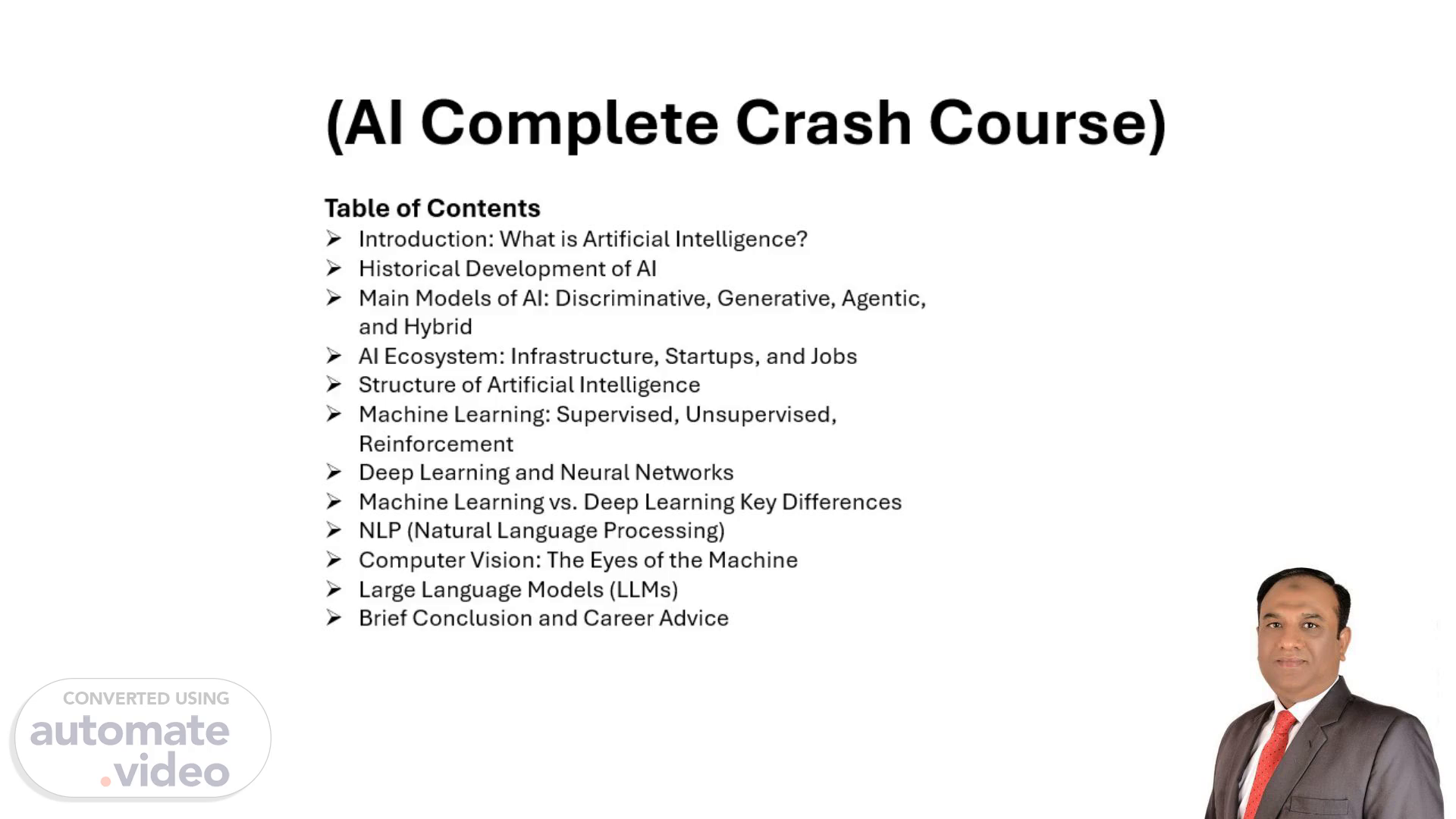Scene 1 (0s)
[Audio] AI Complete Crash Course Table of Contents Introduction: What is Artificial Intelligence? Historical Development of AI Main Models of AI: Discriminative, Generative, Agentic, and Hybrid AI Ecosystem: Infrastructure, Startups, and Jobs Structure of Artificial Intelligence Machine Learning: Supervised, Unsupervised, Reinforcement Deep Learning and Neural Networks Machine Learning vs. Deep Learning Key Differences NLP (Natural Language Processing) Computer Vision: The Eyes of the Machine Large Language Models (LLMs) Brief Conclusion and Career Advice.
Scene 2 (43s)
Introduction: What is Artificial Intelligence?. Artificial Intelligence (AI) is a branch of computer science that aims to create machines that can work with human-like intelligence. AI can also perform tasks that require human abilities such as thinking, reasoning, problem solving, understanding language, and vision. In this changing technological world, knowledge and understanding of AI has become extremely important for your career and employment today..
Scene 3 (1m 4s)
[image]. [image]. [image]. Beginning (1950–1980 basic model) lan Turing published a paper in 1950 and put forward the idea of AI. In 1956, John McCarthy introduced the term 'AI' to the public. In the early years, basic programs and chatbots like ELIZA were created..
Scene 4 (1m 33s)
Discriminative Models: Their purpose is to classify data e.g. spam detection in emails, face recognition, fraud alerts, etc. Generative Models: These generate data or content, e.g. ChatGPT generates text or DALL-E generates images. Agentive AI: These are capable of making decisions and performing tasks, e.g. self-driving cars, personal assistant Auto-GPT. Hybrid Models: By combining both discriminative and generative capabilities, more multi-tasking models are created e.g. self-driving cars..
Scene 5 (2m 1s)
[image]. 1 2 3. Infrastructure builder companies Companies like OpenAI (ChatGPT), Google, Meta, NVIDIA, Antropic develop AI models and infrastructure..
Scene 6 (2m 25s)
[image]. . . .. Machine Learning (ML) A subpart of AI where models are trained to learn from data. ML includes training data, algorithms, and predictions..
Scene 7 (2m 47s)
[image]. Supervised Learning The model is taught to understand patterns from labeled data so that it can make accurate predictions on new data, such as image classification, spam detection..
Scene 8 (3m 12s)
Deep Learning and Neural Networks. Deep learning is an advanced form of machine learning where neural networks inspired by the human brain are used. The input layer, hidden layer, and output layer work together to process data and make decisions. The layers of the network help in tasks like pattern detection, image/speech recognition, etc. Deep learning is effective only with large amounts of data and powerful hardware (GPUs/TPUs)..
Scene 9 (3m 34s)
Data Requirement Machine learning works well on small-medium data sets, deep learning requires huge data..
Scene 10 (3m 59s)
[image] poove. NLP is the branch of AI that allows computers to understand, interpret, and generate human language. It is used in chatbots, voice assistants (Alexa, Siri), sentiment analysis, language translation, etc. NLP relies on a lot of data, specific algorithms (Transformers, LSTMs), and various software providers..
Scene 11 (4m 18s)
Computer vision: the eyes of the machine. Computer vision is a field of AI that teaches machines to interpret and process images, photos and video data. For example, in self-driving cars, the machine identifies obstacles ahead with the help of camera signals. Models like CNN, YOLO, ResNet are prominent in the development of computer vision..
Scene 12 (4m 37s)
[image]. 1. 2. 3. Definition LLMs are AI models trained on large text data that can generate or understand human-like language (e.g. ChatGPT, Bard)..
Scene 13 (5m 0s)
Brief conclusion and career advice. The field of AI is growing rapidly; employment opportunities will grow rapidly in infrastructure companies, startups and various sectors such as healthcare, finance, e-commerce. It is important to have a strong basic of AI, which opens up interviews and career options. A strong grip on topics such as supervised and unsupervised learning, deep learning, NLP, computer vision and LLMs will prove to be extremely beneficial..
